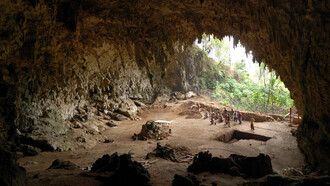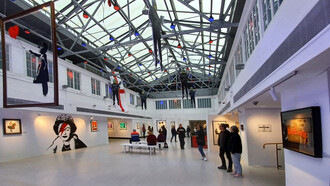I have always admired Jeff Wall for two reasons; the first is that he has managed to escape, Houdini-like, from the incarceration of stereotyping that has ruined so many of his contemporaries’ careers. The second is that the works themselves, through their quicksilver quality, have aided and abetted this escape. Wall really came to the fore from the late 70’s Vancouver art scene, but since then has sustained an extraordinary career, successfully bobbing and weaving between art historical reference and photographic convention.
Over the past 50 years, Wall’s imagery has bounced stylistically through hyperrealism, photojournalism, docu-drama and cinematography. Further to this, I would argue that Wall is an artist worthy of continued attention given the unique ability of his work to push the attitudinal fader between the optimism of ‘70’s conceptual art toward the fertile, social disillusion of punk rock.
In terms of earlier practice, Wall has regularly referenced magnum opus ‘snapshots’ by the likes of Delacroix The Death of Sardanapalus (1827), for his 1978 composition The Destroyed Room; Manet’s A Bar at the Folies-Bergère (1882), parodied in Wall’s 1979 Picture for Women, and Hokusai A Sudden Gust of Wind, After Hokusai (1993), in order to re-animate their topical relevance.
The exhibition at central London’s White Cube Gallery presents some new and recent works that give yet more pause for thought: Parent child (2018) offers a view of a sidewalk in a suburban shopping district on a sunny summer day. A man gazes down at a little girl who lays down on the sidewalk. The neutrality of the behavioural snapshot leads us to speculate as to why. Is this a tantrum, exhaustion, a game? We are tantalised and implicated as we occupy this strange limbo between preceding and subsequent events. Neither are we clear if Wall has constructed this ‘near documentary’ image, or if it is actually an image of a real event.
For me, Wall’s most stunning work in the show, Weightlifter (2015), possesses some of the same ‘stagey’ qualities but also harks back in its monochromatic portrayal well beyond its age. The photograph triggers a pre-steroid nostalgia for a sport that was never really a sport. Weightlifting, of all competitive activities, also epitomises the struggle between the individual’s interior world and exterior presence/impact/perception. Wall’s image captures the very complex dynamic between competition and narcissism evoking a nostalgia for a pre-steroid era, restoring some dignity to the labour of the lifter in non-narcissistic isolation.
Mother of Pearl (2016), is an altogether different proposition, another tableau, but this time located in a domestic setting choked with antique furniture mementoes. The girl seems fascinated by a set of old pearlescent tokens. We wonder about the family, the significance of the counters and the role of the girl in the bedroom. She may be an interloper, but more likely, it seems the buttons seems to evoke an internalised game or some symbolic meaning beyond our grasp.
Hillside near Ragusa (2007) was made in the autumn of that year near the Sicilian city of the same name. The Sicilian landscape, again rendered in monochrome, looks harsh and unforgiving, littered with ancient tracery in the form of Greco-Roman building remains. Hillside is most likely a homage to, and part of the compulsion that one often feels between the evidence of extinct ancient civilisations and our own mistaken sense of permanence.
I could go on and on about this show, it is, as they say in some circles, a target-rich environment. It sometimes makes hard work, sometimes slightly discomfiting viewing (Property line (2015)) but Wall is maybe one of the few photographers who really understands the chemistry between image, interpretation and meaning. The confidence of the work and his mastery speaks volumes, I for one am sure that he means what he says. As a viewer, I find myself striving to come to terms with uncertainty within photography, but also wrestling with my own narrative apparatus and sensory acuity. Not a bad outcome.















